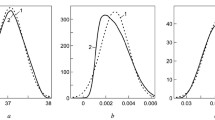Abstract
The present study summarizes the measurement uncertainty estimations carried out in Nestlé Research Center since 2002. These estimations cover a wide range of analyses of commercial and regulatory interests. In a first part, this study shows that method validation data (repeatability, trueness and intermediate reproducibility) can be used to provide a good estimation of measurement uncertainty.
In a second part, measurement uncertainty is compared to collaborative trials data. These data can be used for measurement uncertainty estimation as far as the in-house validation performances are comparable to the method validation performances obtained in the collaborative trial.
Based on these two main observations, the aim of this study is to easily estimate the measurement uncertainty using validation data.




Similar content being viewed by others
References
Eurachem/CITAC. Quantifying Uncertainty in Analytical Measurement. QUAM:2000.P1. 2000
ISO. Guide to the expression of uncertainty in measurement. Geneva, Switzerland. 1993
EUROLAB. Measurement uncertainty in testing. Technical Report No 1/2002. 2004
Ellison SLR, Barwick VJ (1998) Using validation data for ISO measurement uncertainty estimation. Part 1. Principles of an approach using cause and effect analysis. The Analyst 123:1387–1392.
Ellison SLR, Barwick VJ (1998) Estimating measurement uncertainty reconciliation using a cause and effect approach. Accred Qual Assur 3:101–105
Barwick VJ, Ellison SLR (2000) The evaluation of measurement uncertainty from method validation studies. Part 1: Description of a laboratory protocol. Accred Qual Assur 5:47–53
Barwick VJ, Ellison SLR, Rafferty MJQ, Gill RS (2000) The evaluation of measurement uncertainty from method validation studies. Part 2: The practical application of a laboratory protocol. Accred Qual Assur 5:104–113
Barwick VJ, Ellison SLR (1998) Estimating measurement uncertainty using a cause and effect and reconciliation approach. Part 2: Measurement uncertainty estimates compared with collaborative trial expectation. Anal Commun 35:377–383
Hund E, Massart DL, Smeyers-Verbeke J (2003) Comparison of different approaches to estimate the uncertainty of a liquid chromatographic assay. Analytica Chimica Acta 480:39–52
Armishaw P (2003) Estimating measurement uncertainty in an afternoon. A case study in the practical application of measurement uncertainty. Accred Qual Assur 8:218–224
Haesselbarth W (2004) Accounting for bias in measurement uncertainty. Accred Qual Assur 9:509–514.
Ellison SLR (1998) ISO uncertainty and collaborative trial data. Accred Qual Assur 3:95–100
Adriaan MH, van der Veen A, Broos JM, Alink A (1998) Relationship between performance characteristics obtained from an interlaboratory study programme and combined measurement uncertainty: a case study. Accred Qual Assur 3:462–467
Guidance for the use of repeatability, reproducibility and trueness estimates in measurement uncertainty estimation. ISO/TS21748:2004
Stöber P, Giller V, Spack L, Prodolliet J (2004) Measurement uncertainty of the HPAE Chromatographic Determination of Instant Coffee Carbohydrates. J AOAC Int 87:647–656
Campos Giménez E, Bénet T, and Spack L. The uncertainty of the calculation of blocked and reactive lysine in milk products, as determined by the furosine method. Accred Qual Assur (2004) 9:605–614
Campos Giménez E, Spack L, Meyer L, Perrin C (2004) Acheson-Shalom, R. Measurement uncertainty of the caffeine determination in soluble coffee by HPLC. Mitteilungen aus Lebensmitteluntersuchung und Hygiene 95:240–250
Spack L, Royer D, Campos Giménez E, Acheson-Shalom R, Stadler R (2004) Measurement uncertainty of chloramphenicol in food products by LC-MS/MS. Mitteilungen aus Lebensmitteluntersuchung und Hygiene 95:223–239
Rousseuw PJ, Croux C (1993) Alternatives to the Median Absolute Deviation. J Amer Statistical Assoc 88, 1273–1283
Royal Society of Chemistry, Is my uncertainty estimate realistic?. AMC Technical Brief 15, 2003
Author information
Authors and Affiliations
Corresponding author
Rights and permissions
About this article
Cite this article
Populaire, S., Giménez, E.C. A simplified approach to the estimation of analytical measurement uncertainty. Accred Qual Assur 10, 485–493 (2006). https://doi.org/10.1007/s00769-005-0036-1
Received:
Accepted:
Published:
Issue Date:
DOI: https://doi.org/10.1007/s00769-005-0036-1




